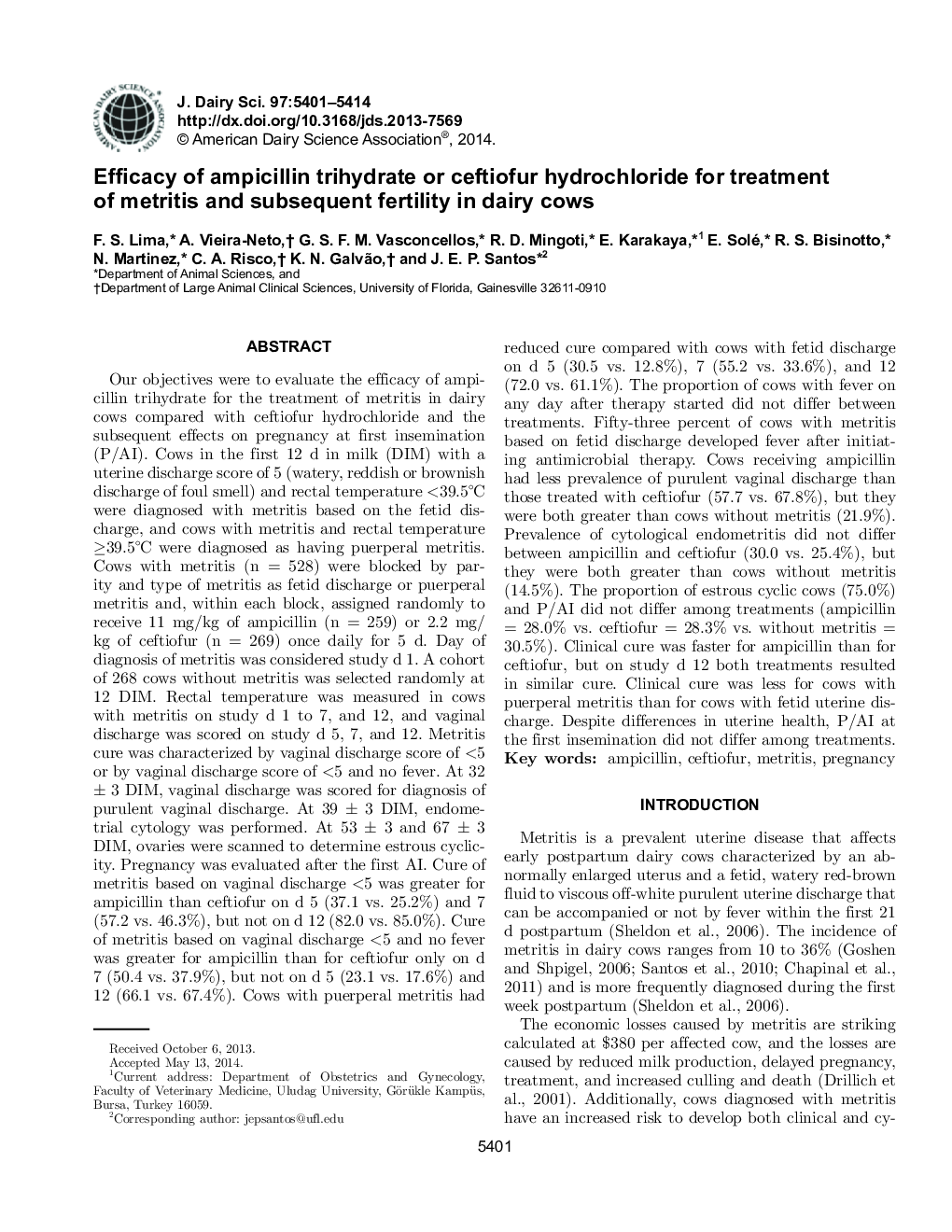| کد مقاله | کد نشریه | سال انتشار | مقاله انگلیسی | نسخه تمام متن |
|---|---|---|---|---|
| 10974101 | 1108022 | 2014 | 14 صفحه PDF | دانلود رایگان |
عنوان انگلیسی مقاله ISI
Efficacy of ampicillin trihydrate or ceftiofur hydrochloride for treatment of metritis and subsequent fertility in dairy cows
ترجمه فارسی عنوان
کارایی تری هیدرات آمپی سیلین یا هیدروکلراید سفتیوفور برای درمان متتریت و باروری بعدی در گاوهای شیری
دانلود مقاله + سفارش ترجمه
دانلود مقاله ISI انگلیسی
رایگان برای ایرانیان
کلمات کلیدی
آمپی سیلین سفیهفور، متریت، بارداری،
موضوعات مرتبط
علوم زیستی و بیوفناوری
علوم کشاورزی و بیولوژیک
علوم دامی و جانورشناسی
چکیده انگلیسی
Our objectives were to evaluate the efficacy of ampicillin trihydrate for the treatment of metritis in dairy cows compared with ceftiofur hydrochloride and the subsequent effects on pregnancy at first insemination (P/AI). Cows in the first 12 d in milk (DIM) with a uterine discharge score of 5 (watery, reddish or brownish discharge of foul smell) and rectal temperature <39.5°C were diagnosed with metritis based on the fetid discharge, and cows with metritis and rectal temperature â¥39.5°C were diagnosed as having puerperal metritis. Cows with metritis (n = 528) were blocked by parity and type of metritis as fetid discharge or puerperal metritis and, within each block, assigned randomly to receive 11 mg/kg of ampicillin (n = 259) or 2.2 mg/kg of ceftiofur (n = 269) once daily for 5 d. Day of diagnosis of metritis was considered study d 1. A cohort of 268 cows without metritis was selected randomly at 12 DIM. Rectal temperature was measured in cows with metritis on study d 1 to 7, and 12, and vaginal discharge was scored on study d 5, 7, and 12. Metritis cure was characterized by vaginal discharge score of <5 or by vaginal discharge score of <5 and no fever. At 32 ± 3 DIM, vaginal discharge was scored for diagnosis of purulent vaginal discharge. At 39 ± 3 DIM, endometrial cytology was performed. At 53 ± 3 and 67 ± 3 DIM, ovaries were scanned to determine estrous cyclicity. Pregnancy was evaluated after the first AI. Cure of metritis based on vaginal discharge <5 was greater for ampicillin than ceftiofur on d 5 (37.1 vs. 25.2%) and 7 (57.2 vs. 46.3%), but not on d 12 (82.0 vs. 85.0%). Cure of metritis based on vaginal discharge <5 and no fever was greater for ampicillin than for ceftiofur only on d 7 (50.4 vs. 37.9%), but not on d 5 (23.1 vs. 17.6%) and 12 (66.1 vs. 67.4%). Cows with puerperal metritis had reduced cure compared with cows with fetid discharge on d 5 (30.5 vs. 12.8%), 7 (55.2 vs. 33.6%), and 12 (72.0 vs. 61.1%). The proportion of cows with fever on any day after therapy started did not differ between treatments. Fifty-three percent of cows with metritis based on fetid discharge developed fever after initiating antimicrobial therapy. Cows receiving ampicillin had less prevalence of purulent vaginal discharge than those treated with ceftiofur (57.7 vs. 67.8%), but they were both greater than cows without metritis (21.9%). Prevalence of cytological endometritis did not differ between ampicillin and ceftiofur (30.0 vs. 25.4%), but they were both greater than cows without metritis (14.5%). The proportion of estrous cyclic cows (75.0%) and P/AI did not differ among treatments (ampicillin = 28.0% vs. ceftiofur = 28.3% vs. without metritis = 30.5%). Clinical cure was faster for ampicillin than for ceftiofur, but on study d 12 both treatments resulted in similar cure. Clinical cure was less for cows with puerperal metritis than for cows with fetid uterine discharge. Despite differences in uterine health, P/AI at the first insemination did not differ among treatments.
ناشر
Database: Elsevier - ScienceDirect (ساینس دایرکت)
Journal: Journal of Dairy Science - Volume 97, Issue 9, September 2014, Pages 5401-5414
Journal: Journal of Dairy Science - Volume 97, Issue 9, September 2014, Pages 5401-5414
نویسندگان
F.S. Lima, A. Vieira-Neto, G.S.F.M. Vasconcellos, R.D. Mingoti, E. Karakaya, E. Solé, R.S. Bisinotto, N. Martinez, C.A. Risco, K.N. Galvão, J.E.P. Santos,
